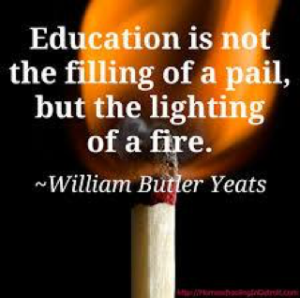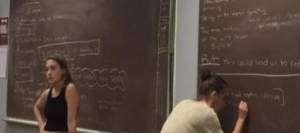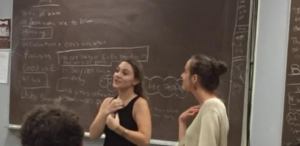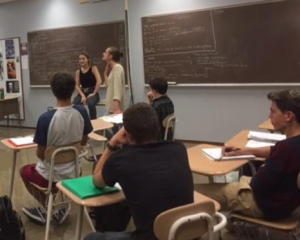I am a high school principal. More importantly, I am an educational leader who is a proponent of student-centered learning – learning that is competency-based, can occur anytime and anywhere, personalized, and promotes student voice and choice. I am at a new school, in a new state. I recently moved from Vermont, a state that has enacted student-centered learning legislation to ensure that every student is prepared for success in college, career and democratic citizenry, to Massachusetts — a state that is recognized as high performing in education, has momentum toward student-centered learning practices, but no actual policies in place. Seemingly, there is cause for reservation yet hope for opportunity.
So you can image how excited I was to discover – within the first few days at my new school, Monument Mountain Regional High School (MMRHS) in Great Barrington, MA, the gem of a class called, Fact and Fiction.
The Class
It is September 13, 2017. I am in Fact and Fiction, the signature 10th grade humanities class at MMRHS. The students are still filing in, settling into a semi-circle of desks and pulling out their materials – a copy of William Faulkner’s “Unvanquished” and ‘call notes’ from the story, “Riposte in Tertio.”
Amid the pre-bell bustle, a student named Leo leans into his neighbor and asks, “What happened to Granny?” This seemingly simple question ignites an explosion of chatter. Over the next hour, within a culture of rigor and respect, I observe wait time, strategies to honor equity of voice, questions that solicit deep thinking, and strong, content knowledge. These are the characteristics of a high quality, veteran teacher; however, there is no teacher present, instead the class is led by two seniors. Inspired by Fact and Fiction, two years previous, Alessandra and Hannah are debuting their literary content knowledge alongside their facilitation skills as “Teacher Assistants”. Yet, they do this without the aid of the assigned ELA and History teachers who team-teach this interdisciplinary, signature course. Again, it is only September 13th.
As an educator and school principal committed to student-centered learning, I am elated as I sit in for the teachers of the class. Once again, I am observing the power authentic student voice has in advancing student motivation and engagement, two factors that are intricately connected to student performance. This class of twenty-three 10th grade students being led by two seniors is living proof. Take this scenario: The ‘on call’ student is grappling with her thoughts. She poses a question – one, if answered, would either reaffirm her analysis or correct her misinterpretation. Teacher Assistant, Hannah, begins to respond. I watch her catch herself. I can see the wheels turn as she takes a moment to instead formulate a question that requires the student to express her feelings and perhaps advance her own thinking. It is evident that she appreciates that her voice is being valued versus being told what to think. After all, education is not about telling, but inspiring independent thought.
Likewise, moments later, Alessandra, the second Teacher Assistant, takes the lead. She listens intently to a student’s perspective, and then intuitively frames the shift he is making for the class in a way that inspired students to think about the concept not only in the context of the story, but as it relates to their own life.
The bells rings – the class is over, and students are visibly disappointed. My mind, my excitement continues to race too. Truly, this is the most authentic student-centered learning opportunity I have experienced, and I want to learn more about how it transpired.
The Interview
I began by asking Alessandra and Hannah to reel back two years, to think about their first day of Fact and Fiction and to recount their initial impression.
Alessandra: “We just hit the ground running. It was intense. We read complex text starting with Faulkner, and we had to be prepared to share our thinking from that day onward. Initially, we didn’t know what was important or how to properly express our thinking using the text.”
Hannah: “At first it didn’t matter. The teachers encouraged us, instilled confidence in us and respected our voice. They empowered us to take risks.”
Alessandra: “Yes, they gave us a safe space for discourse. Our skills developed over the course of the year, and so did our sense of purpose; we were learning to think critically about oneself and the world, what it means to be true to yourself and about goodness and truth.”
Hannah: “I didn’t know it, but I had been longing for this type of opportunity; that is to be challenged to think differently and to be comfortable with the fact that there are more questions than answers. The class was transformative for me.”
So the year ends, and I ask them to recant – what next, and why become a Teacher Assistant for Fact and Fiction?
Hannah: “I did an independent study my junior year. Fact and Fiction was a public space for my thinking, I then wanted a private space to think, work, and to explore my passions – to know what I really loved and what motivated me. Then becoming a Teaching Assistant for Fact and Fiction my senior year was the next logical step. I wanted to re-approach the texts, engage in listening to new perspectives and practice asking really good questions.”
Alessandra: “I knew I wanted to be a Teaching Assistant for Fact and Fiction, and Mr. Wohl approached me; it was like he read my mind.” I wanted to re-experience the texts, but in a different way. I wanted to guide and mentor others. The discussions would be different – they always are, and we learn from each others’ uniqueness.”
Fact and Fiction – The Course and the Teacher
To read about Fact and Fiction in the MMRHS Program of Studies, it sounds like any other high school humanities course that integrates American Literature and History: “Fact and Fiction is a team-taught, double-period course taught by an English and Social Studies teacher. It chronologically covers American history and literature from Colonial to Contemporary times with attention to a wide variety of texts and perspectives.”
Simply, the description does not do it justice. One core value of teaching and learning as outlined in the MMRHS mission statement is to ‘create opportunities that challenge all to become courageous learners’. The approach utilized in Fact and Fiction embodies this value. Jolyn Unruh and Matt Wohl see themselves as facilitators/coaches who are providing young adults with an opportunity to not only think critically and make sense of abstract concepts, but to carry them out – endorse their thinking in practice, and be courageous.
“Fact and Fiction is an exercise for life. We design the course so that the literary characters and historical figures challenge our students to think about who they are as human beings and Americans and how does one then go about living to embody those characteristics and values.”
Fact and Fiction and the Role of a Teacher Assistant
At Monument Mountain Regional High School, there are two ways students can engage in the teaching process. The first is to be a ‘Community Helper’ and the other is to be a ‘Teacher Assistant’, and each has its own ‘job’ description.
The Community Helper works behind the scene doing tasks to support the teacher in managing his/her classroom ranging from photocopying, preparing for labs, and/or other clerical tasks. The Teacher Assistant is considered an opportunity within the Internship Pathway. Students must work with the mentor teacher, set goals, progress monitor those goals and keep a journal that reflects on their learning. The Teacher Assistant role can range from working 1:1 with students in the class doing tutoring to lesson planning or teaching lessons.
In Fact and Fiction, the Teacher Assistant’s role is more of a representation of the person who is the TA, versus carrying out delineated tasks assigned by the teacher. Wohl sees the TA opportunity as a ladder; “a means for the TA to crossover or climb beyond the initial Fact and Fiction experience and to have a space to reflect on the impact – i.e. and ask, “How have I applied the learning of that initial experience in my own life?” For some TAs this has transpired into being a ‘fly on the wall’, occasionally weighing in on class discussions, journaling and reflecting on their own. For others, like Alessandra and Hannah, it is an opportunity to be a peer leader, to share the application of their learning, including how they, like the characters, have been challenged by moral questions. According to Unruh and Wohl, both have value for the TA; however, the latter has a powerful impact on the current students.
“As teachers / coaches in this course, we break it down for students, build up their confidence, provoke them through questioning and provide feedback. The Teacher Assistants though can provide something we can’t. They can remember what it felt like to first experience the struggle. They can remember the questions the characters / historical figures raised for them – how they felt and what it would mean for them as a fifteen year old. Simply, that is just something a teacher cannot do, despite our depth of knowledge and experience.”
The Future of Student Voice – Leading the Learning
Yes, we do learn from “each other’s’ uniqueness”. Recent discoveries in adolescent brain development have provided new insight in how students need to learn knowledge and skills to make learning ”stick” and to be successful in school and in life. The application of this research, are policies, practices, and system designs for student-centered learning inclusive of a growth mindset, Universal Design for Learning (UDL) principles, competency-based education, learning anytime anywhere, personalization, and student voice and choice.
The story of Alessandra and Hannah is evidence of the impact of student-centered learning. Their initial experience, 10th graders enrolled in Fact and Fiction, demonstrates that when students are provided structured opportunities to grapple with challenging content within a culture of learning that is inclusive, respectful, and honors voice then students become participants in their learning – stakeholders with a vested interest. This in turn positively influences student motivation and engagement. Thanks to two exceptionally innovative and skilled teachers, for Alessandra and Hannah, it didn’t end here though.
Alessandra and Hannah’s learning experience shifted from one of participation to one of partnership and leadership. As teaching assistants for Fact and Fiction, they have become true collaborators. Within this opportunity, the teachers of the course, are sharing their authority, both as the identified experts in the room – the keepers of knowledge, and as the adults responsible for student outcomes. By accepting this shared responsibility, Alessandra and Hannah are leaders of learning – their own, and that of the 10th grade students in Fact and Fiction. Simply, I can’t imagine a more empowering scenario for developing student autonomy.
Amy Rex is the principal of Monument Mountain Regional High School in Great Barrington, Massachusetts. She previously served as co-principal at Harwood Union High School in Vermont, where she was recognized as one of Vermont’s 2017 Principals of the Year.
SaveSave
SaveSave
SaveSave
SaveSave
SaveSave
SaveSaveSaveSave
SaveSave
SaveSave
SaveSaveSaveSave
SaveSave
SaveSave
SaveSave
SaveSave
SaveSaveSaveSave
SaveSave



